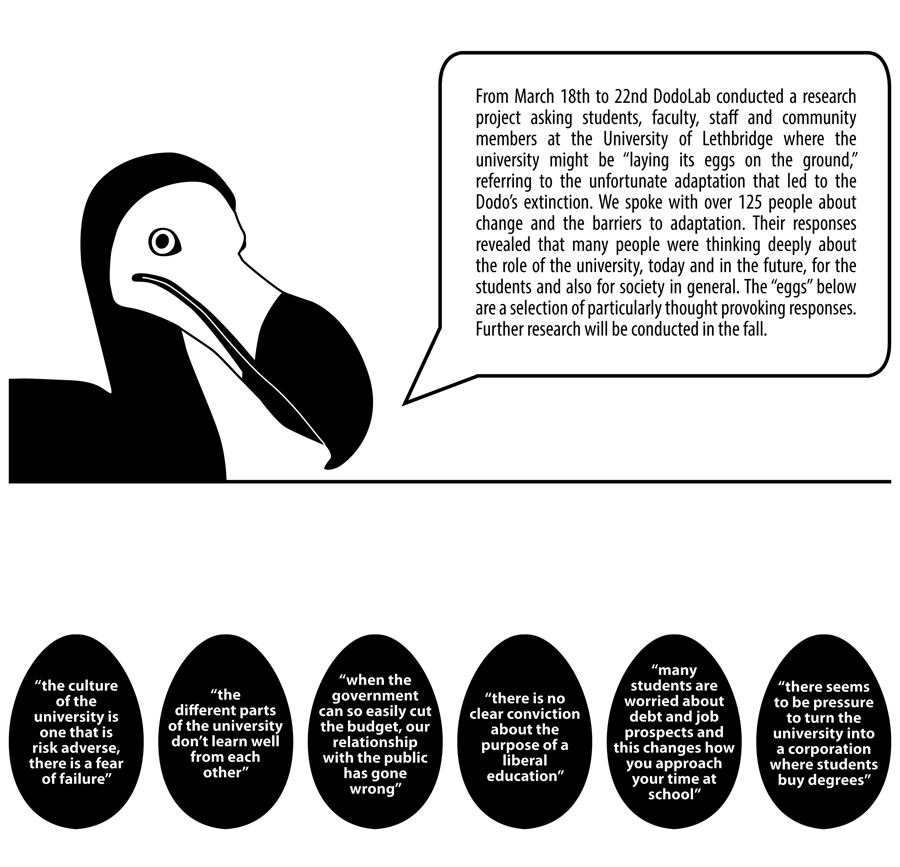The Anatomy and Etiquette of Social Change
March 18 – 22, 2013
Part of the Complex Social Change Series
Curator: Josephine Mills
A public engagement project with art/design duo DodoLab featured on the University of Lethbridge Art Gallery’s “Project Wall” outside the Main Gallery.
DodoLab: The Anatomy and Etiquette of Social Change
DodoLab is developing The Anatomy and Etiquette of Social Change creative research program with a focussed investigation of the University of Lethbridge with the goal of extending their investigation to additional institutions and communities as part of Complex Social Change (ULAG). The program begins by applying the framework (based on the story of the extinct dodo bird) of adaptation to an island environment to different situations. Dodos were adapted to their unique environment in a number of ways, including increased size, loss of the ability to fly and laying their eggs on the ground (all related to an abundance of easily accessible food and a predator free environment). Such adaptations proved fatal when significant introduced changes occurred within their environment.
The Anatomy and Etiquette of Social Change program will be launched at the University of Lethbridge in the spring of 2013 with the sharing of the dodo narrative. Told as a graphic/comic tale, this narrative will be presented on campus in various forms including an installation on the gallery’s new interactive wall, on line and in print. It will be the basis for a series of field research inquiries with students, staff and faculty, both in classes and informally around campus. Dodolab wants people to consider the risks their community or institution may face due to select adaptation strategies, moments of laying one’s eggs on the ground. Social and operational structures, planning and development methods, traditions and rituals, organizational arrangements and cultural attitudes, are some examples of adaptations. Over the coming months, the dodo narrative will evolve and be added to based on the feedback and so a unique dodo narrative will emerge that is specific to the University of Lethbridge. The goal is to document areas of concern within the institution and to highlight opportunities for considered change.
The Anatomy and Etiquette of Social Change is the second major project by DodoLab developed with the University of Lethbridge Art Gallery. It follows their Important Things To Know About Eating and Drinking (In Lethbridge) in 2011 and builds on their ongoing creative research work with institutions and communities across Canada and Internationally.
***
DodoLab is an evolving collaborative program lead by artists Lisa Hirmer and Andrew Hunter engaged with provocative, experimental and creative approaches to research and community actions. Their work is critically playful and highly public, emphasizing open participation and exchange. The state of the natural world, adaptive challenges to communities and institutions, the built environment and cities in transition are their primary areas of interest. They employ creative interventions, surprise encounters, innovative publishing and design, and genuine collaborations to enhance and encourage public conversations, dialogue and knowledge sharing within and across cultures, generations, disciplines (and sometimes species). They are partially supported in their work by the Musagetes Foundation with whom they share a commitment to art as social catalyst. Their work is further supported by commissioned collaborations with individuals and organizations in Canada and Internationally (including universities, municipalities, social service organizations and the arts).
DodoLab uses the archetypal extinct species in its name/logo as a reminder that we need to consider the risks of isolated and narrowly defined adaptive strategies (the Dodo could not survive outside of its predator free island environment). Are we “Dead as a Dodo” or potentially “Going the way of the Dodo” if we do not learn to adapt, change and work together? The dodo reminds us that a lack of resiliency and a solo existence is a precarious strategy for survival. For generations, the Dodo has also been understood to have been a slow, lazy, glutinous bird with limited intelligence. It is now believed that this large flightless bird may have actually been reasonably intelligent and active and that the unflattering characteristics usually associated with the bird may have been the result of encounters with overfed, captive species – basically, specimens living in an artificial, human designed environment of overabundance. This is a reminder that sometimes the stories we tell become barriers to understanding and resolving the issues we face.
The Anatomy and Etiquette of Social Change: The Results


39 thoughts on “The Anatomy and Etiquette of Social Change
March 18 – 22, 2013
Project Wall | Centre for the Arts | W600”